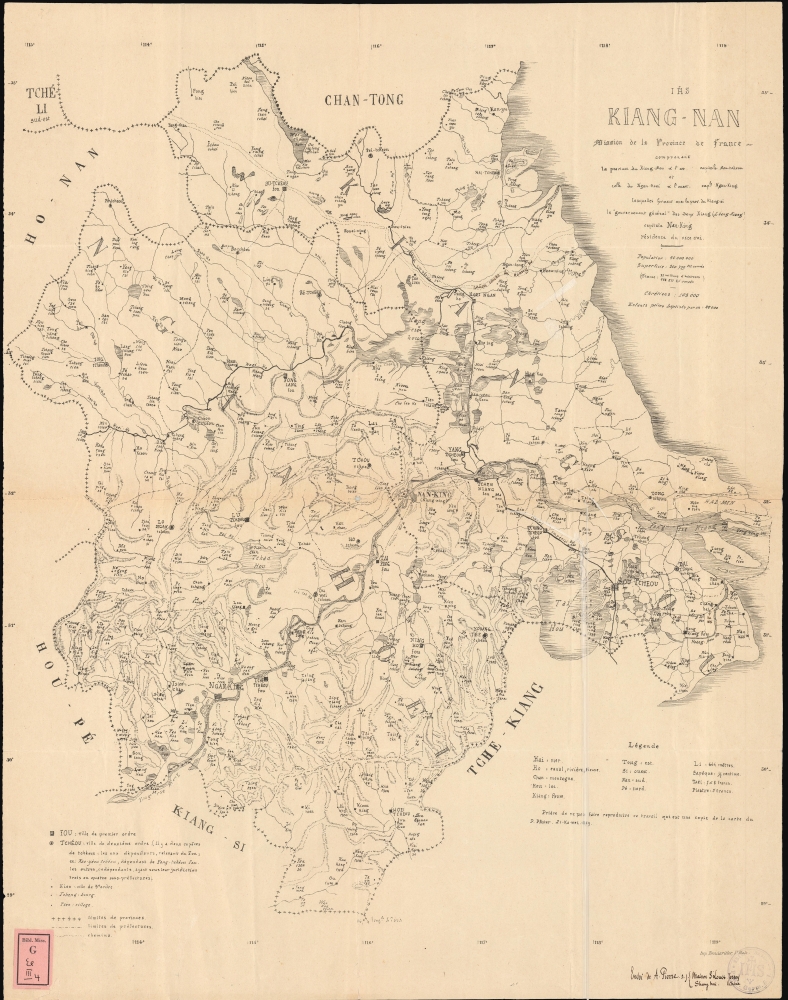1879 Jesuit Pfister Map of the Kiang-Nan Vicarate, Jiangnan Province (Shanghai), China
Kiangnan-pfister-1879
Title
1879 (dated) 22 x 17.25 in (55.88 x 43.815 cm)
Description
A Closer Look
The map illustrates the French Jesuit-run Kiang-nan Vicariate, an apostolic territory roughly corresponding to the former Jiangnan Province (江南), China. The map includes the major Chinese cities of Shanghai (上海市), Suzhou (苏州市), and Nanjing (南京市), among others. The Grand Canal appears winding from the north, while dotted lines illustrate significant roads. Differing symbols indicate village sizes, from major cities (Fou) to small villages (Tsen). A legend in the lower right features a dictionary of transliterated Chinese geographical terms. Shanghai ('Chang hai') is identified as a 'Fou' along the Huangpu River, but is notably smaller than nearby Suzhou and Nanjing. The Xujiahui (Zi Ka Wei) Mission house is noted in manuscript just southwest of Shanghai. A note attributing the map to Aloys Pfister also warns against making copies, suggesting that the information contained within was both sensitive and tightly guarded.Kiang-Nan Mission
Based in Nanjing, the Kiang-nan Mission was established by French Jesuits in the lower Yangtze River region of China, encompassing areas around modern-day Shanghai and Jiangsu province. During the 19th century, amidst the backdrop of the Qing Dynasty and increasing Western influence, the Jesuits in Kiang-nan worked not only to spread Christianity but also to engage in cultural exchanges. Known for their educational and cultural approach, Jesuit missionaries contributed to scientific and intellectual advancements by introducing Western sciences, mathematics, and astronomy, while also learning from Chinese cultural and philosophical traditions. With deep roots in a region dominated by the treaty ports of Nanjing and Shanghai, the Kiang-nan Mission was well-protected and suffered few of the anti-foreign attacks that marked missionary work elsewhere in China. The thriving mission nonetheless came to an abrupt end in 1949 with the establishment of the People's Republic of China.Provenance
The map bears two library stamps, confirming it was deaccessioned by a German Jesuit library sometime in the 1980s. The library stamp remains in the lower left, and its mark appears in the lower right. It is difficult to decipher, but it reads 'Prov. Germ. S. J.', resolvable to 'Provinciae Germaniae Bibliotheca Scriptorum Societatis Jesu', perhaps located in Cologne. We have seen numerous other maps with the same stamps, all very rare, many unique manuscripts, so the deaccession must have been significant. A German dealer acquired the deaccessioned maps, and pieces with similar marks occasionally appear on the market, representing all parts of the world.Publication History and Census
Alois Pfister initially drafted this map at the Xujiahui Library (Zi-ka-wei), near Shanghai. It appears to have been printed by Imprimerie Benderitter, St. Malo. We note just one other example, located at the Österreichische Akademie der Wissenschaften.CartographerS
Aloys Pfister (April 24, 1833 - May 17, 1891), also known as Louis Pfister, or in China, Fei Lai Zhi (費賴之) was a French Jesuit missionary, priest, historian, and sinologist active in the Shanghai region, China. Pfister was born in Gerbeviller, Meurthe, France. He joined the Society of Jesus in 1852, after which, in 1867, he was sent to the Kiang-non Mission. Within that mission he spent many years ministering to the inhabitants of Hai-men (海门), and the alluvial island of Chongming (崇明岛). Although he had many converts, he did not consider himself successful relative to the overall population. In 1881, he retired to the mission house and library at Xujiahui Library (Zi-ka-wei), southwest of Shanghai. He remained there until 1889, when in failing health, he moved to Shanghai. There in 1891, he died of heart disease. He is best known for this Notices biographiques et bibliographiques sur les Jésuites de l'ancienne mission de Chine. 1552–1773, a history of early Jesuit missionary work in China. More by this mapmaker...
Xujiahui Library (1847 - Present), today known as the Shanghai Library Bibliotheca Zi-Ka-Wei (上海图书馆徐家汇藏书楼) was established in 1847. It was initially part of the Jesuit mission complex in the Xujiahui village (徐家汇), situated on the outskirts of Shanghai. Following the Jesuit mission of scholarship, it evolved into an academic center embracing both Chinese and Western academic heritages. It was also an important publishing house, issuing maps, religious works, scholarly studies, and more. By the end of the 19th century, it housed over 200,000 volumes. The library is known for its comprehensive collection of Chinese gazetteers, newspapers, reference materials, and mission-related publications. The establishment of the People's Republic of China marked the end of the Jesuit mission in Xujiahui. Nonetheless, the library perseveres, having been nationalized and, from 1957, integrated into the Shanghai Library System. Learn More...
Benderitter (fl. c. 1865 - 1918) was a French printing house with facilities in Le Mans, Rouen, and St. Malo in the late 19th and early 20th centuries. Learn More...

